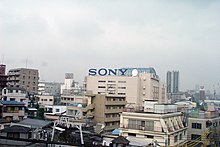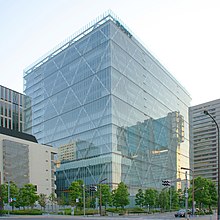History of Sony
Here is the further information about the history of Sony, an iconic Japanese multinational conglomerate company.
Founding[]
In September 1945, after the end of World War II, Masaru Ibuka started a radio repair shop in the bomb-damaged Shirokiya department store building in the Nihonbashi district of Tokyo. The next year, he was joined by his wartime research colleague, Akio Morita, and on 7 May 1946, they founded a company called Tokyo Tsushin Kogyo K.K.[1] (Tokyo Telecommunications Engineering Corporation). The company produced Japan's first tape recorder, called the Type-G.[1]

In the early 1950s, Ibuka traveled to the United States, looking for a market for the company's tape recorder, and heard about Bell Labs' invention of the transistor.[1] He convinced Bell to license the transistor technology to his Japanese company. Bell Labs agreed to do so while recommending Ibuka to produce Hearing aids using the transistor, then a popular application for the technology, suggesting that it would be difficult to apply the technology to radio. While most Japanese companies were researching the transistor for its military applications, Ibuka and Morita looked to apply it to communications.
Although the American companies Regency Electronics and Texas Instruments built the first transistor radio as joint venture in 1954, it would be the Ibuka's company that made them commercially successful for the first time.[2]
As an innovator[]
In August 1955, Tokyo Tsushin Kogyo released the Sony TR-55, Japan's first commercially produced transistor radio.[3] They followed up in December of the same year by releasing the , a product that won favor both within Japan and in export markets, including Canada, Australia, the Netherlands and Germany. Featuring six transistors, push-pull output and greatly improved sound quality, the TR-72 continued to be a popular seller into the early sixties.
In May 1956, the company released the TR-6, which featured an innovative slim design and sound quality capable of rivaling portable tube radios. The following year, 1957, Tokyo Tsushin Kogyo came out with the TR-63 model, then the smallest (112 × 71 × 32 mm) transistor radio in commercial production. It was a worldwide commercial success.[1] The company marketed the radio as "pocketable", a Japanese-style English word the company came up with to highlight its portability and pocket-size. The word soon featured in English dictionary.[4]
University of Arizona professor Michael Brian Schiffer, PhD, says, "Sony was not first, but its transistor radio was the most successful. The TR-63 of 1957 cracked open the U.S. market and launched the new industry of consumer microelectronics." By the mid-1950s, American teens had begun buying portable transistor radios in huge numbers, helping to propel the fledgling industry from an estimated 100,000 units in 1955 to 5,000,000 units by the end of 1968. As a result of the popularity of transistor radios, which empowered privacy and individualism, the way people listen to radio or music has changed forever. Sony also launched the world's first integrated circuit radio, the ICR-100 in 1967.
Following the first success in American consumer market, Tokyo Tsushin Kogyo changed its name to Sony in 1958 as people outside Japan struggled to pronounce the original name. Sony established Sony Corporation of America, the company's first subsidiary in America, in 1960. And in the same year, Sony made another innovation by releasing the world's first non-projection type all-transistor and portable television, Sony TV8-301.
In 1961, Sony launched the world's first compact transistor VTR, the . In 1968, Sony launched the legendary color television set, Trinitron. The Trinitron was the reason that Sony had been the world's largest TV manufacturer in terms of annual revenue until 2006.[5][6]
In 1969, Sony launched Sony TC-50, a compact cassette recorder. NASA equipped every astronaut with the device from Apollo 7 onwards. Astronauts were required to use the recorder to log their missions but they also listened to music by inserting and playing the pre-recorded tapes. Masaru Ibuka also enjoyed listening to classical music using recorders, preluding the birth of Walkman. In October the same year, Sony released a prototype of the world's first commercial videocassette recorder. This led to the official launch of the VP-1100 two years later.
Sony received the Emmy in 1973 for developing the Trinitron. This was the first Emmy awarded to an electronics. In 1975, Sony launched the Betamax, which took part and lost in the video format war.
Walkman, the first stereo cassette player, was launched in 1979. The year 1981 is considered as a starting point of the Digital Revolution with Sony launching the world's first Compact Disc player, the Sony CDP-101, with a Compact Disc (CD) itself, a new data storage format Sony and Philips co-developed.[7] In that year, a 3.5-inch floppy disk structure was introduced by Sony and it soon became the defacto standard.
Sony is also the company that produced the first color video camera using a CCD, the . The Sony Mavica, released in 1981, is a prototype of the world's first commercial electronic still camera.
Sony played a significant role in the tech industry in the second half of the 20th century alongside Hewlett-Packard and IBM. Steve Jobs, fascinated by the company's innovative products, culture and work environment, was a big fan of Sony and regarded the company being in a league of their own, apart from the other comparable competitors.[8]
In 1991, Sony released the first commercial lithium-ion battery jointly with Asahi Kasei and had been the leader in the rechargeable battery industry until a massive defective battery scandal occurred in 2006.
Sony introduced Memory Stick, a flash memory storage format, in 1998, a year earlier than the announcement of SD card. The Sony's format is considered as a yet another failed standard from the company. The list of Sony's unsuccessful attempts to make their proprietary formats universally adopted includes Betamax, MiniDisc or the well-known abbreviated term, the MD, and Universal Media Disc.
Beyond an electronics powerhouse[]
Sony played a major role in the development of Japan as a powerful exporter during the late 20th century.[9] From the late 80s to early 2000s, it aggressively expanded into a variety of businesses, from film (Sony Pictures Entertainment) and insurance (Sony Life) to banking (Sony Bank) to internet service providing (So-net) and gaming (Sony Interactive Entertainment).[9] It also beefed up the music business it had operated in Japan, CBS/Sony Record, and turned it into Sony Music Entertainment, a multinational music label group. Part of its motivation for expansion was the pursuit of "convergence," linking film, music, and digital electronics via the Internet.[9] However this strategy ultimately failed, merely damaging Sony's balance sheet and making the company's business structure highly complex.[9]
Crisis and challenges[]
Howard Stringer, the first non-Japanese CEO of Sony, helped to reinvigorate the company's struggling media businesses, encouraging blockbusters such as Spider-Man while cutting 9,000 jobs.[9] Despite modest success, the company faced continued struggles from the mid 2000s and started to lose the leading position in the tech industry.[9] It became known for its stagnancy, with a fading brand name.[9]

Sony's headquarters moved to Minato, Tokyo from Shinagawa, Tokyo around the end of 2006.[10][11]
References[]
- ^ Jump up to: a b c d "Sony Global – Sony History". Archived from the original on 28 November 2006. Retrieved 16 February 2007.
- ^ Hongo, Jun, "Once one and only, Sony seeks to regain that status", Japan Times, 22 May 2012, p. 3 Archived 8 January 2013 at the Wayback Machine
- ^ "Sony Global – Product & Technology Milestones-Radio". Retrieved 16 December 2002.
- ^ "Sony Global – TIME CAPSULE vol.7". www.sony.net. Retrieved 30 April 2020.
- ^ Ramstad, Evan (27 December 2011). "Samsung Electronics Ends LCD Venture With Sony". Wall Street Journal. ISSN 0099-9660. Retrieved 30 April 2020.
- ^ Cain, Geoffrey. Samsung Rising: Inside the secretive company conquering Tech.
- ^ Trenholm, Richard. "Photos: The history of the digital camera". CNET. Retrieved 30 April 2020.
- ^ "Steve Jobs' Sony Envy [Sculley Interview]". Cult of Mac. 14 October 2010. Retrieved 30 April 2020.
- ^ Jump up to: a b c d e f g Christian, Caryl, and With Hideko Takayama and Kay Itoi in Tokyo, George Wehrfritz in Hong Kong, John Sparks and Michael Hastings in,New York. "Sony is Not Japan ; the Appointment of a Foreign CEO is a Sign of how Far the Iconic Company has Fallen in the Japanese Corporate Elite." Newsweek 21 March 2005: 30-. ProQuest Research Library. Web. 26 May 2012.
- ^ Suzuki, Kyoko. "Sony Considers Sale of Properties Including Former Headquarters." Bloomberg. 3 August 2006. Retrieved 19 January 2009.
- ^ "Sony to close symbol of TV business.." Kyodo News International. 1 February 2007. Retrieved 19 January 2009.
- History of computer companies
- Sony